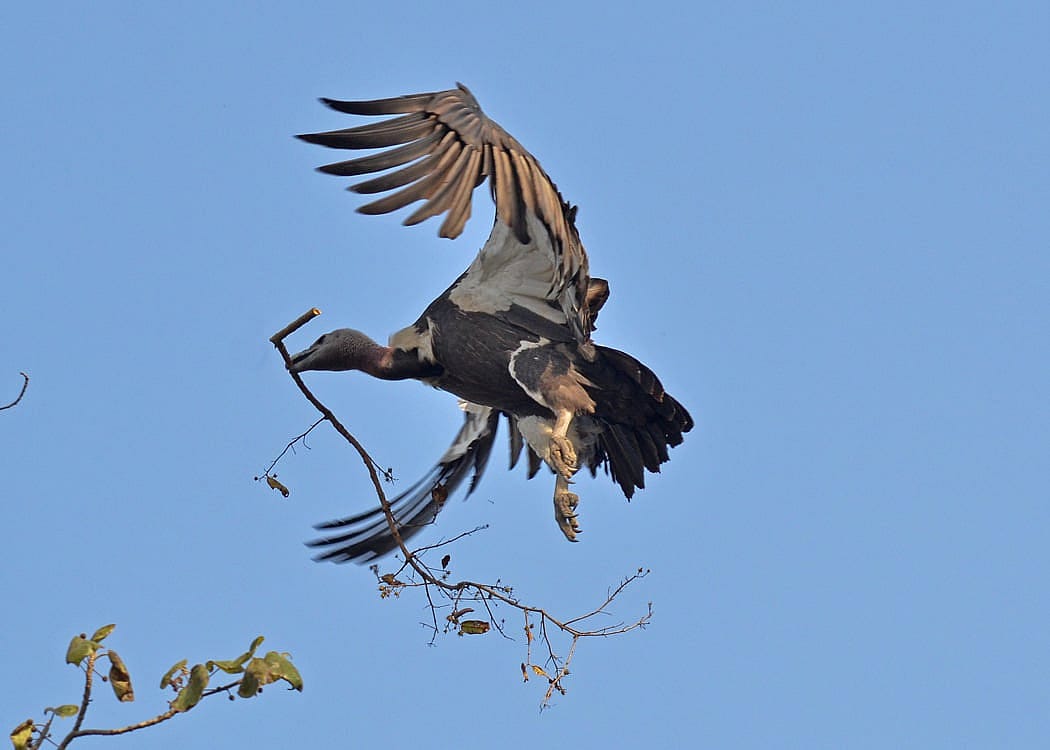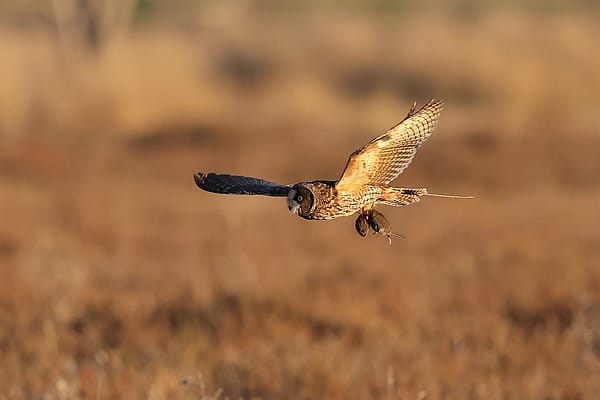
Vultures: Fallacies and Truths
Charles Darwin was certainly not impressed with Turkey Vultures when he first saw them. He noted, “These disgusting birds, with their bald, scarlet heads, formed to revel in putridity.” Yet he seems to have had a better opinion of condors when he wrote, “It is truly wonderful and beautiful to see so great a bird, hour upon hour, without any apparent exertion, wheeling and gliding over mountain and river.”

Many people would agree with Darwin’s evaluation. With preconceived notions that vultures are ugly, filthy, stinky birds that possibly carry diseases, you can’t blame some people for thinking vultures are disgusting.
Not all vultures are bald, and in reality they can be quite beautiful. The Bearded Vulture, for example, has a feathered head. Plus all vultures play an important roll in keeping our environment safe and healthy.
Vultures Don’t Spread Diseases
Vultures have such strong acids in their stomachs that they can kill anthrax, botulism, cholera, rabies, and many more dangerous diseases. When vultures clean a carcass that has died of a serious disease, the disease is destroyed within their digestive system. This causes carcasses to be sterilized, thus eliminating diseases. Without scavengers there would be an increase in carcasses, therefore an increase in disease.

An example that demonstrates this can be found in India where cattle have been treated with an anti-inflammatory drug called Diclofenac. Unfortunately, when vultures dined on the discarded carcasses of cattle the Diclofenac caused kidney failure. Between 1992 and 2007, the population of White-rumped Vultures is estimated to have declined by 90 to 99%. Long-billed Vultures and Slender-billed Vultures have met a similar fate. As a result, the job of cleaning up cattle carcasses was taken over by feral dogs. The dog population boomed, along with rabies which then spread throughout their population and into the human population. It’s been estimated that the increase in cases of rabies has cost India over 30 billion dollars.
Is Their Life an Easy One?
Some people think being a vulture is easy as they don’t have to kill their prey. More over, they may hang around predators and steal their kills. In truth, vultures do not get their food by simply stealing it from others, though they do share in meals where possible.
Relying on dead things can be hard work. As scavengers, vultures need to search for an animal that has died and is still fairly fresh. Contrary to popular belief, it has been documented that Turkey Vultures prefer to dine on carcasses less than four days old. It may take hours to locate and many miles covered before something suitable is found. Turkey Vultures may range up to 140 square miles while hunting, and the African Bearded Vulture may range up to 925 square. miles. And if nothing is found they, like other raptors, go hungry.

But They are So Ugly!
The Cherokee people called North American vultures “Peace Eagles” as they do not kill, rather they feed on animals that are already dead. Furthermore, from a distance vultures can resemble an eagle in flight. Beauty is all in the eye of the beholder, and many people who have negative opinions about vultures will often admit they are graceful and beautiful when soaring. Though once on the ground, these same people may state they are dirty and disgusting.
Why? Mainly because most have no, or very few, feathers on their heads and faces. So let’s think about that. How do vultures feed? They will dine by standing on a carcass, tearing edible bits off. In addition, they will plunge their heads deep inside a large carcass. Now picture their bald or almost bald heads. Think what would happen if they had a lovely feathered face. How would they look after pulling their heads out from deep inside a carcass? Imagine those lovely feathers being ruffled backwards collecting bits of innards as the bird pulls its head out. Now, that would be a picture of ugliness. Vultures, with their bare faces and pin feathered heads, pick up blood but not nearly as much of the other innards as a feathered head would.

Living in the United States you may reside in a community that commonly has a year-round or seasonal population of Black and/or Turkey Vultures. Take the time to observe their feathers as they stand in the sun. Like crows, ravens, and many other dark feathered birds their feathers pick up iridescent colors of purples, blues, and greens. It often surprises our visitors how beautiful Suli, the Draper Museum Raptor Experience’s Turkey Vulture, is when she is standing in the sun.
Are They Really Dirty Birds?
Vultures like to be clean as much as any other animal. As previously mentioned, with their baldness they don’t get as filthy-dirty as one may expect. Coupled with that, they enjoy bathing and take advantage of safe, shallow water sources to clean up.

Furthermore, vultures love to sunbathe. If you live in an area where they can be commonly seen, you will have observed them in their horaltic pose, perching with wings spread wide. In this way they can warm up if needed, as well as possibly absorb vitamin D. In addition, the sun will dry up any small bits of guts that they may have accumulated while feeding, and through the shaking and preening process these will fall off.

Do Vultures Stink?
I have firsthand knowledge that Suli, our Turkey Vulture, has no natural unpleasant body odor. However, like many animals, when she defecates it can be quite unpleasant smelling. Moreover, their vomit smells horrible. New World vultures are not equipped with strong feet for defense, so escaping quickly is their method of safety. If they have been gorging on a carcass, they must lighten their load. Vomiting, therefore, becomes their defense mechanism. Some predators will enjoy checking this out, possibly eating it, and in all probability at least cause a predator to pause in their attack. Again, from experience, I must say, vulture vomit is one of the smelliest odors I can think of. So the bird itself is not stinky, but they can at times certainly create some stink.

So in the final analysis, vultures have an undeserved reputation. They are nature’s clean-up crew. They work hard at their job, and are not naturally dirty birds. Even though you may not find them as attractive as your favorite feathered-head bird, taking a closer look at them will help you find beauty in a bird that does an essential job of keeping our planet a healthier place to live.
Photo Credits:
Bearded Vulture by Toni Syvanen, Attribution-NonCommercial-NoDerivs 2.0 Generic license, https://www.flickr.com/photos/syvanen/
White-rumped Vulture carrying a stick by Patty McGann, Attribution-NonCommercial, Generic License, https://www.flickr.com/photos/pattymc/
Soaring Vultures, and Vulture preening in tree by author, Attribution-NoDerivs Generic License, https://www.flickr.com/photos/157982666@N07/42781502891/in/album-72157699189720901
Suli in horaltic pose while perched on a long, downloaded from the Draper Museum Raptor Experiences Facebook page, https://www.facebook.com/pg/DraperMuseumRaptorExperience/posts/?ref=notif
Turkey Vultures in Horaltic pose in Nevada by Tatiana Gettelman, Attribution, NonCommercial, ShareAlike License, https://www.flickr.com/photos/tatiana-gettelman/
King Vulture by Eric Killby, Attribution-ShareAlike License, https://www.flickr.com/photos/ekilby/
Written By
Anne Hay
Anne Hay has a Bachelor's degree in Elementary Education and a Master's in Computers in Education. She spent most of her working years teaching third grade at Livingston School in Cody, Wyoming. After retiring she began doing a variety of volunteer work for the Buffalo Bill Center of the West’s Draper Natural History Museum. Anne loves nature and has a concern for the environment. She believes that educating the public, so that they will have a better understanding and appreciation for the natural world, is very important. Because of this belief, volunteering at the Center is a perfect fit. She spends time in the Draper Lab, observing eagle nests for Dr. Charles Preston’s long-term research project on nesting golden eagles, writing observation reports of raptor sightings in the Bighorn Basin, and working with the Draper Museum Raptor Experience. Anne states that, “Having a bird on my glove, is one of my all time favorite things in life.”










